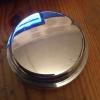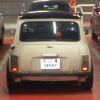
Adjusting Disc And Drum Brake Clearance.
#1

Posted 24 April 2016 - 02:25 PM
Kind Regards
George
#2

Posted 24 April 2016 - 04:40 PM
#3

Posted 24 April 2016 - 04:54 PM
the discs are very stiff and quite corroded as well so maybe time for a new set of discs and brake pads?No adjustment on disc brakes there is nothing to hold the pads off the discs, they will drag slightly. drum brakes there is a square adjuster, tighten till the wheel is locked then back off about 1/4 turn, will still drag a bit
#4

Posted 24 April 2016 - 06:13 PM
When was the car last used?
Edited by monkey, 24 April 2016 - 06:16 PM.
#5

Posted 02 May 2016 - 10:26 PM
A picture speaks a thousands words, how much is quite corroded? Lol, discs will get rusty when stood but that will rub off after a few taps of the brake pedal - this is normal. I guess they shouldn't be very stiff, I would remove the brake pads and see if it's still stiff, just to ensure it definatly is the pads/discs causing the stiffness. If it is it isn't nessasarily down to worn/faulty pads/discs, could be a piston siezed in the calliper etc
When was the car last used?
I think it is just a little too corroded to leave so i ordered new discs and pads, but the grinding sound was actually from the wheel bearings which i am changing as soon as i get a spare weekend! Also the car was in daily use right up until the brake servo failed so its not like it had been stood for any amount of time.
Edited by WimpyMiniMan, 02 May 2016 - 10:27 PM.
#7

Posted 06 May 2016 - 04:42 PM
Just a footnote on rear wheels/brakes.... You do NOT want rear brakes (or any drum brakes) to spin freely.
Correct adjustment on drums requires that an elevated wheel can be spun by hand and stop within about 1 revolution. You should be able to hear a small amount of shoe drag noise as the wheel is spun. If you adjust the brakes so the wheels spin freely you will end up with excessive brake pedal travel.
#8

Posted 24 July 2016 - 12:45 PM
No adjustment on disc brakes there is nothing to hold the pads off the discs, they will drag slightly. drum brakes there is a square adjuster, tighten till the wheel is locked then back off about 1/4 turn, will still drag a bit
Disc brake adjustment
The piston seal design is such that it pulls the piston back in once the pressure is released, this is a designed distance to allow a running clearance between the disc and pads.
Adjustment is taken up as the pad wears it slides a few microns through the piston seal and when released it retracts the desired amount.
Therefore pressing the pedal pushes the piston/s out through the seal to allow the pad to contact the disc.
piston movement = seal retraction distance + wear of pad at the specific time you press the pedal, when released the piston retracts (the seal retraction distance) but because of the wear in the pad (the last operation) it moves back to a point that is slightly further out than when you started.
Think 2 steps forward 1 step back each time you apply the brakes.
#9

Posted 30 July 2016 - 10:42 AM
#10

Posted 14 August 2016 - 03:37 PM
I have to wonder who it was that came up with such elegant simplicity, accomplished just by using a square section seal in the cylinder bore? Presumably someone at Dunlop?
The first disc brakes where developed in 1890 but serious production didn't start till 1950+ and no information appears to be available about who it was that developed the retraction / seal method...
#11

Posted 18 August 2016 - 01:15 PM
First development in the 1890's...
Not sure it's specific on the designers and developers other than brand names.
But would be nice to put a name on the inventor. 😀
Maybe someone has an old tech book somewhere...?
Edited by MacGyver, 18 August 2016 - 01:16 PM.
#12

Posted 21 August 2016 - 04:32 PM
#13

Posted 21 August 2016 - 07:17 PM
Wiki's disc brake history is nice.
First development in the 1890's...
Not sure it's specific on the designers and developers other than brand names.
But would be nice to put a name on the inventor.
Maybe someone has an old tech book somewhere...?
Frederick William Lanchester patented the disc brake for automobiles in 1902. He used it on his 12hp Lanchester in 1903.
It worked very well but the 'pads' were made from copper and the brakes screeched dramatically.
He made many pioneering contributions to the automobile world, both engines, transmissions and suspension.
#14

Posted 21 August 2016 - 10:11 PM
Glad this topic came up. I've discovered Google have a patent search feature. It's just US patents, they've always been better managed than ours.
#15

Posted 11 October 2016 - 07:42 AM
I have a further question on rear brakes with the car clear of the ground if I pull the rear wheels in and out I have about half a centimeter free play. Is this normal?
1 user(s) are reading this topic
0 members, 1 guests, 0 anonymous users




















